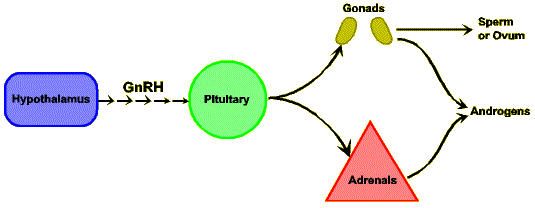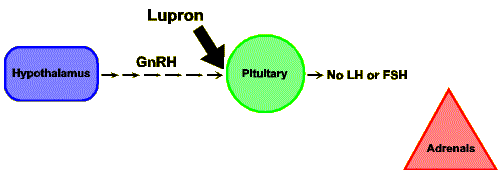|
1. Naturally occurring steroids in the mammal
While the word “steroid” often receives negative attention due to
the use of synthetic steroids by professional athletes, it has long been
known that the mammalian body produces a number of its own natural steroids
which are essential for normal functioning of the body. It has been useful
to divide the natural steroids produced by the mammalian body into two
groups:
- the androgens (a.k.a. the “sex steroids”) — which are produced
primarily by the gonads (testicles in the male animal, and ovaries in the
female animal). Examples of sex steroids include estrogen, progesterone
and testosterone. The androgens are important for normal sexual
development and reproduction.
- the corticosteroids (a.k.a. the “adrenal steroids”) — which are
produced by the cortex (outermost layers) of the adrenal gland. Examples
of adrenal steroids include cortisol and aldosterone. The adrenal
steroids are important for maintaining normal metabolism and body fluid
electrolyte balance. The production of corticosteroids is controlled
separately from production of sex steroids.
While this neatly classifies natural steroids by their site of
production and is still very useful for a basic understanding, it has been
discovered that sex steroids can also be produced in small amounts by the
adrenal glands. Thus, the production of sex steroids can continue even in
neutered animals lacking gonads. Ordinarily, this continued production of
sex steroids has little consequence, since the animals are incapable of
reproducing.
However, in the case of adrenal disease in the domesticated ferret
(a.k.a. hyperadrenalcorticoidism), the adrenal gland begins to
produce much higher amounts of sex steroids than it would normally. This
elevated level of sex steroids will lead to the very serious health
problems associated with adrenal disease. It is not known for certain what
causes the adrenal gland to become overactive — there may be more than
one possible cause. It is known that under normal conditions the adrenal
gland is controlled by the pituitary gland, as part of an overall endocrine
system called the "HPA axis."
2. The HPA axis:
The adrenal glands, located above the kidneys, are under the chemical
control of the pituitary gland, which is located below the base of the
brain; in turn, the pituitary gland is under the direct control of an area
of the brain known as the hypothalamus. Together, the hypothalamus,
pituitary and adrenal glands form one of the major endocrine systems of the
body, commonly called the H-P-A axis (see fig. 1).

Figure 1: The Hypothalamus–Pituitary–Adrenal, or HPA Axis
In the context of sex steroid production (by either the gonads or by the
adrenal glands), the hypothalamus first releases a chemical called GnRH
(gonadotropin release hormone) which goes directly to the pituitary, GnRH
is released by the hypothalamus in short, discrete pulses — not in a
steady stream. In response to GnRH, the pituitary is itself stimulated to
releases its own hormones, which are called luteinizing hormone (LH)
and follicle-stimulating hormone (FSH). The LH and FSH enter the
bloodstream and will travel to the gonads to stimulate production and
maturation of sperm or ovum for reproductive purposes (fig. 2). They will
also increase the level of sex steroids produced by the gonads.

Figure 2: Normal Androgen Production via Pathways of HPA Axis
Since the adrenal glands are also capable of limited production of sex
steroids, they too will respond similarly to the LH and FSH, and increase
their androgen output.
3. Overproduction of sex steroids in adrenal disease:
The problem of adrenal disease in ferrets arises when a small portion of
the adrenal gland called the zona reticularis begins to
overproduce and release sex steroids into the body. The most direct method
of correcting this problem has been removal of the affected adrenal gland(s):
no more adrenal gland means no more zona reticularis, therefore no more sex
steroids (assuming the ferret has also been neutered).
The downside of this approach, aside from the general risks involved
with any invasive procedure, is that removal of the adrenal gland can also
deprive the body of the various other hormones that are also produced by
the adrenal gland. These include the other adrenal steroids (cortisol,
aldosterone) and adrenalin (which is produced in the adrenal medulla, or
interior). If BOTH adrenal glands need to be removed, the ability of the
ferret to make these necessary hormones will be severely diminished. Often
hormone replacement therapy is necessary to ensure recovery of the ferret.
As described earlier, the adrenal glands are under the control of the
pituitary gland. Hormones (FSH and LH) released from the pituitary gland
into the bloodstream travel to the adrenal gland and “turn on” sex
steroid production and secretion. Thus, an alternative method of reducing
the secretion of sex steroid from the adrenal gland would be to block the
pituitary gland from producing FSH and LH (fig. 3).

Figure 3: Adrenal Gland Overreacts to Pituitary Hormones
If these pituitary hormones were absent from the body, sex steroid
production and secretion by the zona reticularis would be substantially
reduced if not eliminated altogether. This approach would make the removal
of the adrenal glands unnecessary and thereby spare the ferret’s ability
to produce the other adrenal hormones. It is by this mechanism —
intervention at the level of the pituitary — that Lupron most likely can
correct hyperadrenalcorticoidism.
4. How Lupron works:
As mentioned earlier, GnRH is released by the hypothalamus in a
pulsatile manner to stimulate the pituitary to release FSH and LH into the
bloodstream. It is necessary for normal pituitary function that the
hypothalamus release GnRH in brief, discontinuous pulses rather than
sustained, continuous secretion. The pituitary gland can and will rapidly
lose its responsiveness to GnRH if exposed to the chemical for extended
intervals of time. This phenomenon is called “desensitization.”
Lupron (leuprolide acetate) is a synthetic version of GnRH. It is more
stable than the natural hormone and therefore is degraded much more slowly
within the body. This is the key to how Lupron works. Once injected into
the bloodstream, Lupron acts at the pituitary gland just as natural GnRH
does. However, since Lupron is administered at a relatively high dosage and
isn’t degraded easily, the sustained presence of the drug actually causes
the pituitary to desensitize, and thus cease production of LH and FSH (fig.
4).

Figure 4: Desensitization of Pituitary by Lupron
Without circulating FSH and LH, the adrenal gland stops production of
androgens, and thus the blood levels of androgens drop and the ferret
recovers from hyperadrenalcorticoidism.
5. Limitations of Lupron Therapy:
While some ferrets with adrenal disease do well on Lupron, the scenario
where a ferret may be unresponsive to Lupron may also exist. This scenario
could arise if the adrenal gland has become diseased in a way such that the
zona reticularis will produce androgens independent of any regulation by
FSH and LH. If this should occur, the adrenal gland would probably continue
to hyper-secrete androgens even after Lupron therapy has reduced levels of
FSH and LH. However, since some ferrets do respond well to Lupron, it is
often worth trying if the ferret owner is uncomfortable with the idea of
surgery as a first remedy.
Also, Lupron therapy is a life-long protocol: the ferret will require
regular doses of Lupron to keep the malfunctioning adrenal gland under
control. In the long run, this can be more expensive than surgery, which is
presumably a one-time procedure.
References
Norris, David O. (1980). Vertebrate Endocrinolology. Lea & Febiger,
Philadelphia.
Murad, Ferid. (1990). “Hormones and Hormone Antagonists.” In
Gilman, A.G., T.W. Rall, A.S. Nies and P. Taylor, eds., Goodman and Gilman’s
The Pharmacological Basis of Therapeutics, 8th ed. Pergamon
Press, New York.
John Hines earned his Ph.D. in pharmacology at the University
of Pennsylvania and currently works in the Lab of Pharmacology at its
School of Veterinary Medicine. Akasha and Nikita, his two beloved ferrets,
have sadly gone before him to the Rainbow Bridge, and are hopefully
patiently awaiting his arrival there. Nikita and Akasha received excellent
veterinary care at the Animal and Bird Health Care Center in Cherry Hill,
NJ.
© 1999 John Hines. All Rights Reserved. Used by
Permission.
Graphic figures courtesy of Steve Bodofsky of
The New Rainbow Bridge
Click here
to visit the original version of this article.
|